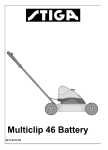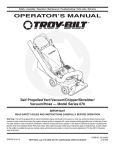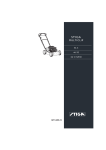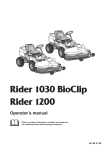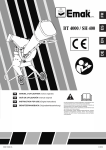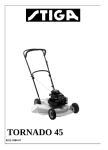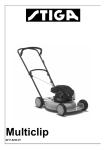Download Stiga 40 Lawn Mower User Manual
Transcript
DEUTSCH Silent 40 Batt 8211-3453-02 D S SVENSKA R 1 R 1 O P 2 2 M 3 M L 3 L K I J K 4 4 I J 5 N 1. 2 230 V 2 2. 4 3. S SVENSKA A BC 4. 5. 6. 7. 8. 9. 36 mm 19 mm 10. 11. 5 GB ENGLISH SYMBOLS The following symbols are displayed on the machine in order to remind you about the safety precautions and attention necessary when using the machine. The symbols mean: Warning! Read the Instruction Book and Safety Manual before using the machine. GRASS COLLECTOR (fig. 2) 1. Snap-together the grass collector's upper and lower parts. 2. Open the cover on the machine and hook the grass collector onto the chassis. Note! The lawn mower can be used without the grass collector. The grass will then collect in a bead behind the machine. BATTERY Warning! Keep spectators away. Beware of objects being flung out. Warning! Take out the safety key before any type of maintenance is carried out. Warning! Do not put hands or feet under the cover of the machine when it is running. Warning! The blades continue to rotate even after the machine has been switched off. STOP When a red lamp lights up on the mower’s control panel and/or a sound signal is activated, take out the safety key. ASSEMBLY STEERING (fig. 1) 1. Press the plugs into the steering sockets. Ensure that the plugs are inserted in the correct end. 2. Press the steering sockets into the holes in the chassis. 3. Fit the screws. Tighten securely. 4. Attach the handlebar to the steering sockets using screws, washers and locking knobs. The handlebar can be tilted forward by loosening the locking knobs slightly. The mower will then take up less space during transportation. 5. Fix the electrical cable using a cable tie. 6 GENERAL Before starting the mower for the first time and after winter storage, you should charge the battery for 1-2 days otherwise the battery can be damaged. In order for the battery to maintain its capacity and to give optimum performance, it is important that the charging and storage instructions are carefully followed. • The battery used in this machine is a lead-acid type battery. This type of battery must always be stored fully charged. • Always charge the battery indoors, in a garage, etc. where the battery is dry and protected from the weather. • Only charge the battery when the temperature is at least 0° C and not over +40° C. Charging in lower or higher temperatures can damage the battery. • Always keep the mower battery away from water, sources of heat (ovens, radiators, open fires, etc.) and hazardous chemicals. • Always use the accompanying genuine Stiga charger. Never use the charger for any other product. • Never use the charger if it is damaged in any way. A damaged lead or charger should immediately be replaced at an authorised service workshop • Take care of the leads. Never carry the charger by the lead. When charging is complete pull out the plug not the lead. If an extension cable is used, use a robust sort suitable for outdoor use, even if the battery is never charged outdoors. ENGLISH • The charger always feels warm to touch, during the first hours of charging. CHARGING INSTRUCTIONS The battery must always be charged directly after finishing mowing and as soon as it has cooled down (after about 30 minutes). 1. Charge the battery outside of the mower in a dry and cool place. 2. First connect the round plug from the charger to the battery (fig. 3). 3. Then connect the charger to a wall socket (~220/230V). 4. Charge for 1 - 2 days, depending on how long the machine has been used. Whilst the battery is charging, the red charging lamp on the battery is continuously lit, for as long as the battery charger is connected 5. Finish charging by firstly pulling out the plug from the wall socket. If the charger is first removed from the battery, the plug leads can shortcircuit if they come into contact with conductive material. CHARGING BEFORE WINTER STORAGE The battery should always be stored fully charged. GB STARTING/STOPPING THE MOWER Keep hands and feet well away from the rotating blade(s). Never put your hand or foot under the blade casing or in the grass ejector unit while the motor is running. 1. Fix the battery in place in the mower (fig. 6). 2. Insert the safety key into the control panel (fig. 7). When the safety key is in place, the green lamp will be lit. If it is not, check that the engine protection on the safety key is pressed in (fig. 8) and that the battery is fully charged. 3. Press down the handle to lift the front wheels off the grass, thereby reducing grass resistance in the starting moment. 4. Press in the power on/off button 1 (fig. 9). Start the engine by pressing in the safety handle 2. To stop, release the safety handle. After finishing mowing: 1. Remove the safety key and keep it out of reach of children. 2. Clean the mower (see the “Maintenance” section under the heading “Cleaning”). 3. Recharge the battery once it has cooled down (after about 30 minutes). If the safety handle has stopped working, remove the safety key and take the mower to an authorised service workshop to be repaired. CONTROL PANEL (fig. 5) 1. Take the battery out of the mower. The control panel has the following functions: 2. Carefully wipe off the battery. 1. It includes the socket for the safety key. The safety key also has an in-built engine protection. If the engine protection has been activated, remove the safety key and reset the engine protection (fig.9). 3. Store the battery outside of the mower in a dry and cool place. USING THE MOWER CUTTING HEIGHT (fig. 4) Individual wheel height adjustment. Note! The same cutting height should be set on all four wheels. 2. It includes three lamps which indicate the battery’s charge level: A Green = the battery is charged to between 30% and 100% of full capacity. B Yellow = the battery’s power has reduced. Between 5% and 30% remains. C Red = 5% or less of the battery power remains. The machine will begin to beep and will switch itself off automatically. Stop mowing and re7 GB ENGLISH charge the battery once it has cooled down (after about 30 minutes). Do not use the mower again until the battery is fully charged. Important: do not allow the battery power to completely run down as this may damage the battery and shorten its operational life. MOWING TIPS For best cutting results and to ensure that the battery lasts as long as possible, the following rules should be followed: • Drive the mower at a slow and even pace • Try to avoid excessive starting and stopping, as this draws a lot of current. Blunt and/or damaged blades tear off the grass and make the lawn look ugly after mowing. New, wellsharpened blades cut off the grass and ensure that it looks green and fresh after it has been mown. Remove the battery. Put the accompanying wrench (36 mm) on the hexagon holder. Loosen the blade nut with an adjustable wrench or another type of fixed wrench (19 mm) (fig. 10). Turn the blade nut in an anti-clockwise direction in order to remove the blade. Fit the new blade and refit all the other parts exactly as they were before they were dismantled, see fig. 10. Tighten the blade nut fully. SHARPENING THE BLADE • Make sure that the motor is running at full speed at all times when mowing. Water grinding with whetstone or a grinding stone should be used to sharpen the blade. • Mow regularly and often, especially when the grass is growing quickly. Do not mow more than a third of the total height of the grass during one mowing session. For safety reasons, the blade should not be sharpened on an emery wheel. Too high a temperature can result in the blade becoming brittle. • Always use a sharp blade. • Do not use the mower when it is raining or when the grass is wet. • Make sure that the underside of the cutting deck is kept clean. MAINTENANCE Take out the safety key and remove the battery before any type of maintenance is carried out. CLEANING The mower should be cleaned after each use. Use a moistened cloth or sponge and a mild soap solution. Do not clean with water or solvents. Remove all grass clippings which might have gathered on the underside of the deck and in the ejector. The grass collector, although not the mower itself, can be cleaned with water. Grass collection efficiency is reduced if the holes are blocked. CHANGING THE BLADE Check, before and after each use, that the blade is tightly fixed and that it is not damaged. A bent or damaged blade should immediately be replaced. Use protective gloves to avoid cutting injuries. 8 If the blade is sharpened, it must be balanced afterwards to avoid vibration damage (fig. 11). ENGLISH Problem GB Possible causes 1. Mower does not start when safety A. Check to make sure the safety key has been properly inserted and that the key is inserted and the safety hanengine protection is pressed in. dle is pressed in B. Remove safety key, turn mower over on side and check that blade is not obstructed. C. Is battery fully charged? Plug in charger and check lamps. 2. Mower stops while mowing (for reason other than releasing the safety handle). A. The engine protection in the safety key has cut off power to protect engine. Wait a couple of seconds for it to cool and then press in the engine protection. B. Remove safety key. Turn mower over and check that blade is free to turn. Also check deck and ejector for clogging. C. Mover is trying to cut too much grass. Raise it to higher cutting height and try to start again. D. Check to see if battery needs to be recharged. 3. Mower vibrates excessively or makes excessive noise. A. Remove safety key. Turn mower over to check if blade is properly tightened. B. Remove safety key. Turn mower over to check if blade has been bent, damaged or worn out. Replace with an original blade. C. Remove safety key. Turn mower over to check mower deck for damage. If damaged, contact an authorised service dealer. D. If no visible damage to mower or blade, return mower to an authorised service dealer. 4. Mower runs but cutting perform- A. Was battery fully charged at the start? ance is unsatisfactory and/or there B. Remove safety key. Turn mower over to check if: is a loss of power while mowing. -blade is correctly attached. -blade is sharp. -blade is bent, loose or damaged. -deck and/or ejector and/or grass collector are clogged C. Cutting height may be set too low, causing heavy strain on motor by trying to cut too much grass. Raise to a higher cutting position. 5. Mower is hard to push. A. Mower is trying to cut too much grass (See problem 4, Cause C.) B. Remove safety key. Turn mower over to check if all wheels rotate freely and check them for damage. Obtain original replacement wheels from an authorised service dealer. 6. Mower engine will not stop when A. Remove safety key to shut off motor. Mower can not then be started. the safety handle is released. Contact an authorised service dealer. 7. Mower cannot finish cutting the A. Was battery fully charged at the start? lawn on a single charge any more. B. Mower is trying to cut too much grass (See problem 4, Cause C.) C. Contact an authorised service dealer for battery check. 8. Mower (in grass collection mode) A. Grass collector is full. is collecting grass poorly. B. Remove safety key. Turn mower over and check deck and ejector for clogging. C. Is the right blade attached? Is the blade sharp? 9. Red lamp on charger does not A. Wall outlet does not have power. (Verify with another electric device.) come on when charger is plugged B. The charger fuse may need to be replaced. Contact an authorised service into wall outlet. dealer C. Charger or cord may be defective. Contact an authorised service dealer. If the mower still doesn't work, despite measures taken according to this table, contact an authorised service dealer. 9








